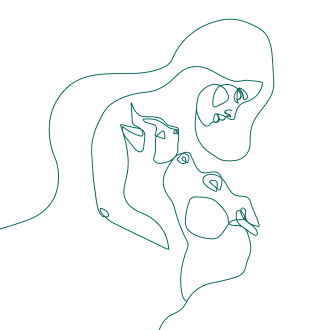About Cats
Cats mew. How these animals communicate
Dec 20, 2021

Oxana Galan, an expert in pet behavior, says:
People are tremendous talkers. Verbal communication is the most understandable and convenient way of communicating for us. Time, however, introduces additional types of communication, and now we continue to communicate sending texts via messaging apps, and often understand each other even without body language and facial expressions. How you can understand a cat that does not answer your question: "How are you?”
Besides "mew", which may be quite different as a matter of fact, cats transmit information in many other ways, not always recognized by us.
The main task of any communication is to be understood and to avoid conflicts that can pose a potential threat to health or life. Therefore, any living being has quite a wide range of possibilities. And the better we learn to understand our predator, the more comfortable our life together will become.
Types of communication are:
- Visual. Mainly involves body and facial expressions
- Vocal. Cats have a very extensive range of vocal sounds.
- Olfactory. Mainly involves urine, feces and scent glands of the body
- Through pheromones. Cat's body parts produce substances that help and complement other types of communication.
Visual communication
Body language can tell you a lot about the mood and intentions of your cat. The balance and position of the tail, ears, whiskers, the shape of the eyes and the size of the pupils — all these should be taken into account when you are trying to figure out whether your pet wants to play or scratch your legs
A calm cat sends neutral signals:
- Soft look in its soulful eyes
- Ears drooping slightly or held up, but not tense
- Head is in a natural position. Your cat neither bends down as in hunting behavior, nor arches its back too much as in a threat display
- Lips and whiskers are relaxed
- The body is relaxed, the balance is distributed over all four legs, like the legs of a table
- The tail is neutral or gently lifted upward with a slight curl at the tip
An anxious and frightened cat displays signals that should be perceived as “Do not get close. I am scared and will have to defend myself":
- A closer look at a frightening object that gives a sense of control
- Tense body, with the balance probably shifted away from the object
- The tail is curved or may be close to the body
- Whiskers are flattened against the side of the face
- The corners of the lips are tense
- Ears are turned sideways or flat and close to the head
- Pupils are dilated
- Respiratory rate increases and breaths appear to be shallow
Generally, you should keep in mind two facts. If your pet tries to become smaller, then it is scared. Your pet is in threatening mode if its tail is puffed up, its hackles are raised and it is standing upright on its hind legs. Body language and facial expressions are incredibly interesting to learn.
Vocal communication
- Purring
- Trilling and chirping
- Growling
- Various types of mews
- Yowl (moan)
- Hissing
- Chirring (chirping)
- Howl
Purring is our favorite feline sound, which can be different and does not always mean relaxation.
Soft quiet purring can indicate that your cat is:
- In a good mood
- Nervous and anxious
- Calming down its partner
This type of purr may also have a therapeutic effect. Sometimes, a cat can start purring even on the vet’s or groomer's table, trying to calm itself down, and this has nothing to do with pleasure. So, do always take into account the specific situation when trying to understand the meaning of a vocal signal.
A vigorous and demanding purr may be an attempt to gain attention or begging for a piece of something tasty.
The so-called trill-and-chirp noise is a soft-voiced short sound that cats often use as a way to attract your attention, a request to follow them, a greeting, and a friendly approach and signal.
Mewing is an incredibly effective signal for feline communication.
Short high-pitched sounds are more likely about feeling confident:
- Please pay attention
- Let me in or out of the room
- Clean the tray
- Feed me
Long, low sounds are more about feeling disturbed. They may signal:
- Pain
- Anxiety
- Fear of loneliness
- Search for something or someone
Olfactory communication
Another way cats communicate with the world is related to scents. And this is the most ancient and widespread channel of communication between animals. It is a complex system cats use in everyday life for:
- Calming themselves down
- Marking their territory
- Signaling that they are in heat
- Identifying members of their own clowder (colony)
Colonies of cats form their own specific scent and can distinguish "friends" from "strangers". Scents are also used by cats to meet and exchange information with unknown cats, which is especially important for feral cats. Animals receive information about each other with minimal risk of physical conflicts, potentially threatening health and life.
The main "means" are urine, feces and the body’s scent glands.
For example, marking urination is fundamentally different from the hygienic one, when a cat first digs a hole in the soil and then carefully buries it in order to mask the smell. If a cat wants to make a noticeable mark, it leaves a little bit of very strong smelling urine on the object, while its tail is twitching in a special way.
Sometimes, a cat can look quite funny, when analyzing the scent left by other felines. This weird face is called the flehmen response, a very complex process during which cats get information contained in a mark or other source of smell using the vomeronasal organ above the palate. First, the cat sniffs long and carefully, without paying attention to anything else, then it opens its mouth and raise its head. A cat frozen with its mouth open and its lip curled back over its teeth (the flehmen response) looks like a congested smartphone performing too many tasks.
Sharpening the claws is also an opportunity to leave a visual and scent cue. So when your cat digs its claws into the sofa next time, think about why it wants to leave extra scent there.
Communication through pheromones
Nowadays pheromones are more often considered as a type of separate communication. There are several main types of pheromones, and each of them has its own specific function. These are volatile substances that are secreted by special glands.
For example, cats mark territory or partners as friendly and safe using scent glands on their cheeks. The pheromones that are released in the area around the nipples soothe and ensure harmony between kittens. There is still not much information about how the pheromones act, but we can definitely say that this is a very important form of communication for our domestic predators.
So, do not be discouraged by the stained white corners in the apartment, which your cat constantly rubs against. Your pet just wants to say that it feels comfortable and safe there. That is what you wanted to achieve, isn’t it?




